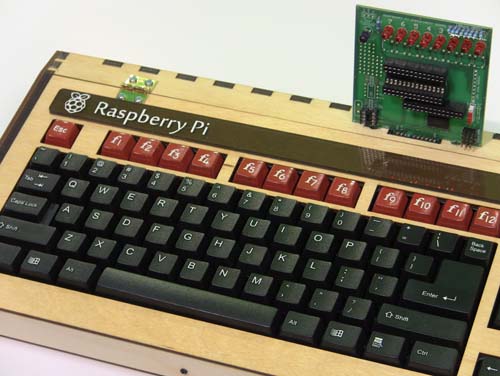A nice slice of Pi. Click for larger version.
Raspberry Pi Project
For the latest episode of the Ben Heck show we built a retro-style case for the Raspberry Pi single board computer.
Features include:
- Power switch and standard barrel power plug / wall wart.
- Card-edge connector (cartridge slot) for easy general purpose I/O breakout.
- Custom PCB’s for experimentation and learning.
- Hinged keyboard allowing easy access to internals and storage for experimentation parts.
To see how it was built and the unit in action, visit element14.com/tbhs.
Click for larger version.



link to element14 is broken 🙂
Sweet Ben!! Loving the show so far. It’s a vessel of education (thumbs up)
Ben – the link that you posted for element 14 is broken.
Hello Ben, I have a suggestion for you using the Raspberry Pi.
You should do a Mythbusters like episode where you try to bust the Hollywood myth of the movie Firewall where Harry Ford use an iPod mini with a scanner and scan 10,000 accounts.
Everybody seem to see this as silly, but I always wonder if I could do something like that using the Raspberry Pi, a scanner on a screen and an iPod as storage for the data ?
After all the Myth seem to come from the iPod the fact the iPod as no software to accommodate the scanner, but we clearly see in the movie a small computer device like the Raspberry Pi connected to it.
The link for the show/contest is http://www.element14.com/tbhs
why do you always expose cables or ugly hinges?
these are parts that make me grind my teeth in otherwise awesome builds.
just fyi, you can actually buy hinges that hide cables inside, and hinges that hide the screws
http://www.amazingdoors.net/hinges-and-power-transfer-products.html
http://www.freemanmarine.com/Hardware/Hinge.jpg
so please give them movable parts some love too
What material do you use for the estructure (the case)? wood?
You don’t seem to respond to the element14 forum, so I’m copying what I said on http://www.element14.com/community/thread/19022?tstart=50 here:
Hi,
I downloaded the zip and was quite diappointed. Firstly, it consists mainly of data sheets. The file ENG_CD_147490_G.pdf has a couple of schematics that are pretty meaningless. There isn’t even a README file.
Lastly, and most importantly, the critical file with the case layout is an Adobe Ilustrator file! I really don’t think that the kind of people that this project will appeal to will want to pay over 500 units of the local currency in order to see the plans of this case.
Yes, I assume that there may exist plenty of places in the USA that have wood/laser cutter services and you expect anyone picking up this file to simply send it on to one of these, but what about people who do not have such access, and merely want to look at the plans in order to adapt/replicate in other ways?
Could you provide the plans in a more industry standard importable form so that, e.g. sketchup could read them? What about DXF ?
Brian Williams
@ nah…. part of the fun in making things is showing off to your friends how you made it… I’m sure Ben could have hidden everything if he so chose but he decided to let it be seen.
@ Brian he put the file in adobe because people are more willing to pay 500 rather than 1200 for any other service. besides if you really cared about making the stuff Ben shows us you should probably just use a saw and go the old fashion way when cutting the stuff.
What are the external disks actually going to do
? i understand the infrared sensors and emitters and how they would work with the group-talking but i’m clueless as to what else you could do with the external disks.